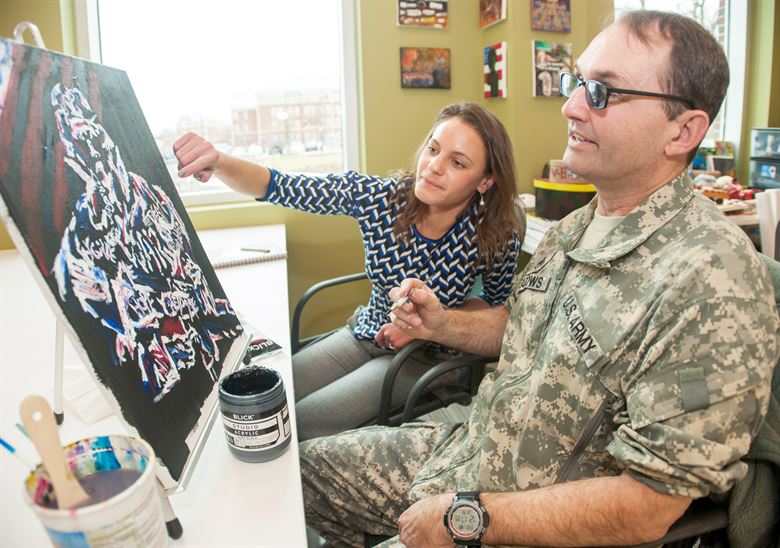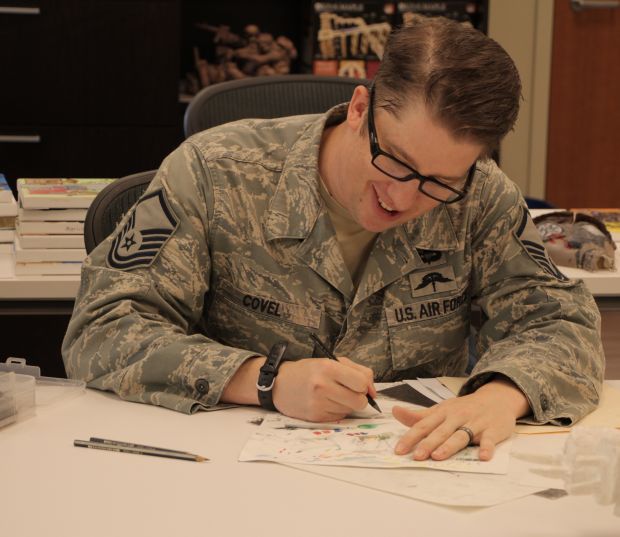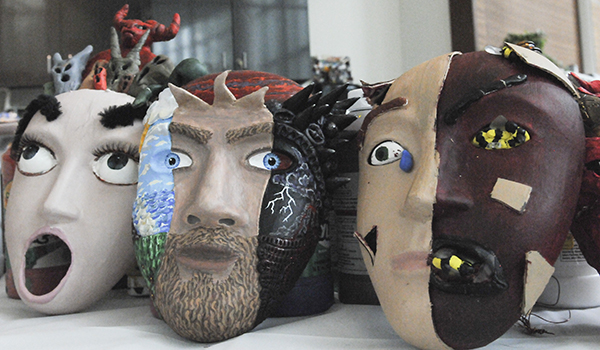The positive effects of arts participation on academics have been widely noted, but the improved self-esteem, willingness to collaborate, and emotional intuition gained by arts participants lend themselves to therapeutic practices as well.
Earlier this year on November 12, the Department of Defense honored the importance of arts therapy for military members at the Healing Arts Recognition Event. Jane Chu, National Endowment for the Arts Chairman, remarked that “arts interventions sit at the core of integrative, patient-centered care. Above all, we are deeply inspired by how these service members use art-making as a tool to bolster their resilience and accelerate their ability to heal, and to carry out their commitment to serve our nation, and their communities and loved ones, to the fullest.” The programs in the Creative Arts Therapy partnership are aimed toward service members who experienced brain injuries and/or have post-traumatic stress and other psychological health conditions.

SGT Timothy Goodrich with his painting “Day 1 or Day 365” at the “Show of Strength” event at the Pentagon. Photo by Sally Gifford. (Source)
So what is creative arts therapy?
NEA Public Affairs Specialist Sally Gifford describes the process as “a non-invasive and cost-effective medical treatment in which certified creative arts therapists work closely with other health professionals to create individual treatment plans with measurable outcomes. Patients may receive therapies such as painting, ceramics, music therapy, and therapeutic writing to improve health conditions for a wide range of medical, physical, neurological, and psychological health issues, such as depression, anxiety, cognitive function, memory, and impaired motor skills.” Patients have exhibited improved cognitive skills, ability to deal with trauma, and ability to face frustrations related to transition processes and grief.
Jackie Biggs, creative arts therapist at the Fort Belvoir Community Hospital, informed NEA writers Don Ball and Rebecca Gross that her patients sometimes describe their activities as “trick therapy. We’re not really tricking them, but just getting beneath the surface in a different way…Sometimes patients wind up feeling so overwhelmed that it’s hard to sort through what exactly is overwhelming them and what really is underlying all those emotions. Through creating the artwork and then talking about it later, they’re usually able to identify and pinpoint really what’s underlying what’s going on, and what they can target in therapy moving forward.”
At the 2015 Wounded Warrior Healing Arts Recognition event at the Pentagon, Assistant Secretary of Defense for Health Affairs Dr. Jonathan Woodson noted that “the progress of creating can lead them places they otherwise [might not] access. It is safe to say we are all just beginning to understand how engagement in the arts can change lives of military members affected by traumatic brain injury to post-traumatic stress syndrome and other conditions. We know [the arts] can be an extremely powerful tool in assisting with recovery.”

Army Staff Sgt. Jonathan Meadows and Jackie Biggs discuss a painting during an art therapy session at Fort Belvoir Community Hospital. Photo by Marc Barnes, Department of Defense. (Source)
Creating art has been shown in studies to decrease stress hormones, relieving anxiety for those who have experienced high-stress environments and high-pressure situations like those encountered while on active duty. Art can help military members express themselves and externalize repressed feelings. Woodson continued in his address that “because of what they’ve experienced, service members often deal with a complex set of feelings and emotions that make it difficult to relate to people. The invisible wounds can lead to feelings of shame, guilt and identity crises that might cause them to retreat and engage in isolating behaviors. Art therapy is a lifeline out of that isolation.”

Air Force Master Sergeant Earl Covel working on an art piece at Fort Belvoir in Virginia. Photo from NEA Arts Magazine. (Source)
For Nonprofit Quarterly’s report on Jane Chu’s Pentagon visit, Eileen Cunniffe profiled Master Sergeant Earl Covel, a “veteran of 12 overseas combat deployments who found himself struggling both physically and psychologically when he returned from his last deployment to a job at the Pentagon.” Cunniffe described that Covel was initially reluctant to participate in art creation, but he ended up completing a challenging self-portrait project – Covel summarized his therapy experiences, expressing that “art has been given back to me. It’s been a gift. I’ll get to take this with me and utilize it to process anything in the future.”

The mask in the middle shows a split sense of self, while the mask on the right portrays chaos going on in the mind of its creator. Photo by Katie Lange, Department of Defense. (Source)
Another notable arts therapy institution that aids military members is the National Intrepid Center of Excellence. At NICoE, patients focus on finding new ways to express themselves and tell the stories of their trauma. Speaking about her patients, art therapist Melissa Walker remarked that “verbally, they might have difficulty explaining what has occurred. They might not be able to tell you exactly how it’s made them feel or affected their lives, but they can show you. It’s about what they’re symbolizing of themselves, and then the end product will be important to them because it’s symbolic of their experiences, identities, etc.”
“A lot of the artwork has a lot of hopeful content – about moving forward, going home and their futures,” Walker continued, and this hopefulness is reflected in the NICoE’s plans for expansion, as well as plans for more art therapists to be placed at military treatment facilities across the U.S. in the upcoming year.
Sources and Further Reading:
“Arts & Human Development Task Force.” National Endowment for the Arts. https://www.arts.gov/partnerships/task-force
Ball, Don; Gross, Rebecca. “Beneath the Surface: Creative Art Therapy at Fort Belvoir, Virginia.” NEA Arts Magazine. https://www.arts.gov/NEARTS/2014v3-healing-properties-art-health/beneath-surface-fort-belvoir
Cronk, Terri Moon. “Art Therapy Provides Lifeline for Wounded Warriors.” U.S. Department of Defense. 12 November 2015. http://www.defense.gov/News-Article-View/Article/628768/art-therapy-provides-lifeline-for-wounded-warriors
Cunniffe, Eileen. “Creative Arts Therapy Helps Military Patients to Heal.” Nonprofit Quarterly. 1 December 2015. https://nonprofitquarterly.org/2015/12/01/creative-arts-therapy-helps-military-patients-to-heal/
Gifford, Sally. “Creative Arts Therapy a Useful Tool for Military Patients.” National Endowment for the Arts. 12 November 2015. https://www.arts.gov/news/2015/creative-arts-therapy-useful-tool-military-patients
Gifford, Sally. “Links between Arts, Learning, and Neuroscience Examined in New NEA Report.” National Endowment for the Arts. 29 July 2015. https://www.arts.gov/news/2015/links-between-arts-learning-and-neuroscience-examined-new-nea-report
Kimmons, Sean. “Art therapy helps close the wounds of Air Force vets.” Air Force News Service. U.S. Air Force. 13 November 2015. http://www.af.mil/News/ArticleDisplay/tabid/223/Article/628816/art-therapy-helps-close-the-wounds-of-air-force-vets.aspx
Lange, Katie. “Art Therapy Helps Service Members Cope With Trauma.” DoDLive. 13 November 2015. http://www.dodlive.mil/index.php/2015/11/art-therapy-program-helps-vets-cope-with-trauma/
Moon, Diana. “Art Therapy May Provide Healing for Service Members.” Defense Centers of Excellence. 26 April 2013. http://www.dcoe.mil/blog/13-04-26/Art_Therapy_May_Provide_Healing_for_Service_Members.aspx
“NEA Healing Arts Partnership.” National Endowment for the Arts. https://www.arts.gov/partnerships/nea-military-healing-arts

Can you be more specific about the content of your article? After reading it, I still have some doubts. Hope you can help me.
Isn’t it entertaining if we always talk about topics like that.’”.~’
This is really stimulating, You’re particularly seasoned article writer. I have signed up with your feed additionally count on enjoying the amazing write-ups. Plus, We’ve shared your web sites in our social networks.
I got what you mean , saved to my bookmarks , very decent web site .
Valuable info. Lucky me I found your web site by chance, and I’m shocked why this accident didn’t happened earlier! I bookmarked it.
Hey there! Wonderful stuff, please do tell us when you post again something similar!
i joined so many seo forum on the internet and they are really quite helpful and i have learned a lot`
Heya just wanted to give you a quick heads up and let you know a few of the pictures aren’t loading correctly. I’m not sure why but I think its a linking issue. I’ve tried it in two different web browsers and both show the same outcome.
I am often to blogging and i also truly appreciate your content. Your content has really peaks my interest. Let me bookmark your web site and maintain checking for brand spanking new information.
A topic close to my heart many thanks, i have been thinking about about this subject for some time.
Does a one day job count as “Work Experience” under the common application?
Dead written content material , Really enjoyed reading through .
Hello! I’ve been reading your web site for a while now and finally got the courage to go ahead and give you a shout out from Kingwood Texas! Just wanted to say keep up the good work!
It’s the little things that matter, that’s what I believe.
Good website! I truly love how it is simple on my eyes and the data are well written. I am wondering how I could be notified whenever a new post has been made. I’ve subscribed to your RSS which must do the trick! Have a nice day!
I love what you guys are up too. Such clever work and exposure! Keep up the very good works guys I’ve incorporated you guys to my own blogroll.
Youre so cool! I dont suppose Ive read anything in this way before. So nice to find somebody with many original thoughts on this subject. realy i appreciate you for starting this up. this fabulous website is one area that is needed on the internet, an individual if we do originality. beneficial purpose of bringing something new for the net!
You may find two to three new levels inside L . a . Weight loss and any one someone is incredibly important. Initial stage may be real melting away rrn the body. lose weight
“Thanks so much for this! I have not been this moved by a blog for a long time!”
Seen the whole article content. There are a little bit of really informative info here. many thanks. “Brilliance is typically the act of an individual, but incredible stupidity can usually be traced to an organization.” by Jon Bentley..
Somebody necessarily lend a hand to make significantly posts I would state. This is the very first time I frequented your website page and to this point? I surprised with the analysis you made to make this particular put up amazing. Excellent activity!
I’ve been wondering about the similar matter personally lately. Glad to see another person on the same wavelength! Nice article.
I’ve been exploring for a little for any high-quality articles or weblog posts on this kind of area . Exploring in Yahoo I finally stumbled upon this web site. Reading this information So i’m glad to express that I’ve an incredibly good uncanny feeling I discovered just what I needed. I most no doubt will make sure to don’t forget this website and give it a glance regularly.
Simply a smiling visitant here to share the love (:, btw outstanding design . CHECK ME OUT BY CLICKING MY NAME!!!
Amazing the following manual is incredible it really helped me and also my children, many thanks!
chefdro? The Stuff- Bryan Armen Graham: Crash Course: Manny Pacquiao vs
It’s best to take part in a contest for one of the best blogs on the web. I will recommend this website!